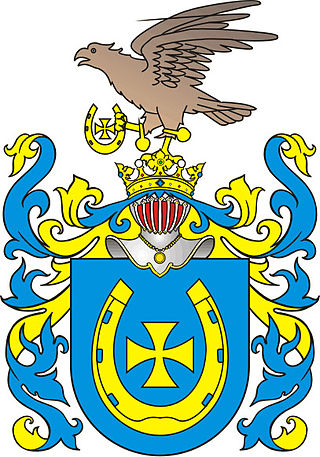
Rudolf II was Holy Roman Emperor (1576–1612), King of Hungary and Croatia, King of Bohemia (1575–1608/1611) and Archduke of Austria (1576–1608). He was a member of the House of Habsburg.

The Defenestrations of Prague were three incidents in the history of Bohemia in which people were defenestrated. Though already existing in Middle French, the word defenestrate is believed to have first been used in English in reference to the episodes in Prague in 1618 when the disgruntled Protestant estates threw two royal governors and their secretary out of a window of the Hradčany Castle and wrote an extensive apologia explaining their action. In the Middle Ages and early modern times, defenestration was not uncommon—the act carried elements of lynching and mob violence in the form of murder committed together.

Ferdinand II was Holy Roman Emperor, King of Bohemia, Hungary, and Croatia from 1619 until his death in 1637. He was the son of Archduke Charles II of Inner Austria and Maria of Bavaria, who were devout Catholics. In 1590, when Ferdinand was 11 years old, they sent him to study at the Jesuits' college in Ingolstadt because they wanted to isolate him from the Lutheran nobles. A few months later, his father died, and he inherited Inner Austria–Styria, Carinthia, Carniola and smaller provinces. His cousin, Rudolf II, Holy Roman Emperor, who was the head of the Habsburg family, appointed regents to administer these lands.
This article contains information about the literary events and publications of 1630.

Matthias Corvinus was King of Hungary and Croatia from 1458 to 1490, as Matthias I. After conducting several military campaigns, he was elected King of Bohemia in 1469 and adopted the title Duke of Austria in 1487. He was the son of John Hunyadi, Regent of Hungary, who died in 1456. In 1457, Matthias was imprisoned along with his older brother, Ladislaus Hunyadi, on the orders of King Ladislaus the Posthumous. Ladislaus Hunyadi was executed, causing a rebellion that forced King Ladislaus to flee Hungary. After the King died unexpectedly, Matthias's uncle Michael Szilágyi persuaded the Estates to unanimously proclaim the 14-year-old Matthias as king on 24 January 1458. He began his rule under his uncle's guardianship, but he took effective control of government within two weeks.

Friedrich Spee was a German Jesuit priest, professor, and poet, most well known as a forceful opponent of witch trials and one who was an insider writing from the epicenter of the European witch-phobia. Spee argued strongly against the use of torture, and as an eyewitness he gathered a book full of details regarding its cruelty and unreliability. He wrote, "Torture has the power to create witches where none exist."

Karel Škréta Šotnovský of Závořice was a Czech portrait painter who worked in the Baroque style. He lived through the Thirty Years' War which caused him some hardships as a Protestant which led him to leave Prague for Saxony then Italy.

The Church of the Assumption of the Buda Castle, more commonly known as the Matthias Church, more rarely the Coronation Church of Buda, is a Catholic church located in the Holy Trinity Square, Budapest, Hungary, in front of the Fisherman's Bastion at the heart of Buda's Castle District. According to church tradition, it was originally built in Romanesque style in 1015, although few references exist. The current building was constructed in the florid late Gothic style in the second half of the 14th century and was extensively restored in the late 19th century. It was the second largest church of medieval Buda and the seventh largest church of the medieval Hungarian Kingdom.
Thomas Pounde was an English Jesuit lay brother.

Kasper Drużbicki or Gaspar Druzbicius was a Polish Jesuit and ascetic writer.

Ralph Corbie was an Irish Jesuit. A victim of the anti-Catholic persecutions following the Reformation, he was beatified in 1929.
Peter Wadding was an Irish Jesuit theologian.
John Warner (1628–1692) was an English Jesuit, known as a controversialist and confessor to James II.
Thomas Everard, Everett or Everat (1560–1633) was an English Jesuit.

Vitus Georg Tönnemann (1659–1740), a German Jesuit, was the only confessor to Emperor Charles VI from 1711 to 1740 - throughout his reign. Despite that position, he is largely a forgotten figure now.
Jan Jiří Heinsch or Heintsch was a Czech-German Baroque style artist. Heinsch primarily painted religious-themed works as well as portraits of monastic superiors – especially for various Catholic religious orders such as the Jesuits, Knights of the Cross with the Red Star or Augustinians. He is known to have produced around 150 paintings and, in addition, extensive graphic work.

Daniel Pawłowski was a Polish Jesuit, theological writer.

Adolf Kajpr SJ was a Czech Catholic priest, Jesuit and publisher of Catholic printed matter. As an ardent preacher, confessor, spiritual leader and journalist, he commented not only on fundamental topics of the Catholic faith but also on current social and political issues. For his opinions he was imprisoned by the Nazis (1941–1945) and the communists (1950–1959). After nine years in the communist prison, he died at the age of 57 “with a reputation of holiness and martyrdom”.
Ignaz Cornova was a Jesuit priest who had spent his life and career in Bohemia. His family provenance was Italian, but his social and professional network revolved around the ethnically German community centred on Prague. He can be variously described as a historian, a teacher, an author and an early representative of the European Catholic Enlightenment movement. He was also a prominent Freemason.

The 1549 Book of Common Prayer (BCP) is the original version of the Book of Common Prayer, variations of which are still in use as the official liturgical book of the Church of England and other Anglican churches. Written during the English Reformation, the prayer book was largely the work of Thomas Cranmer, who borrowed from a large number of other sources. Evidence of Cranmer's Protestant theology can be seen throughout the book; however, the services maintain the traditional forms and sacramental language inherited from medieval Catholic liturgies. Criticised by Protestants for being too traditional, it was replaced by the significantly revised 1552 Book of Common Prayer.












